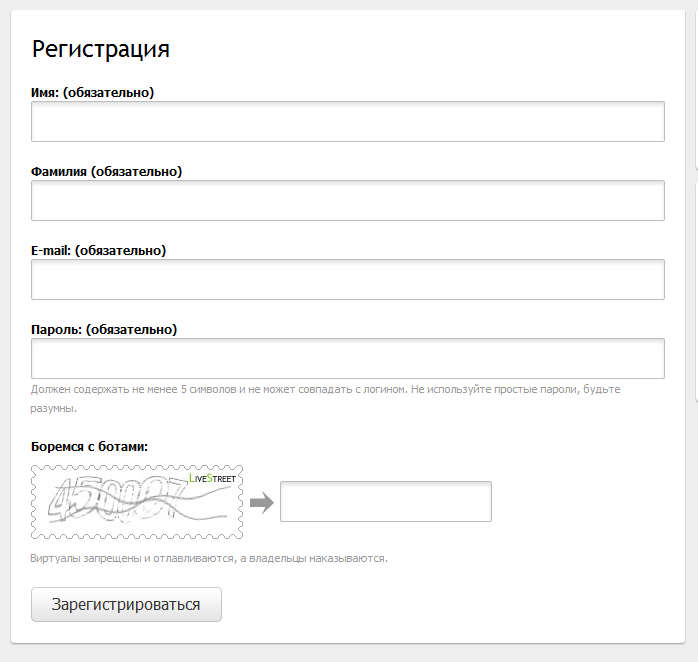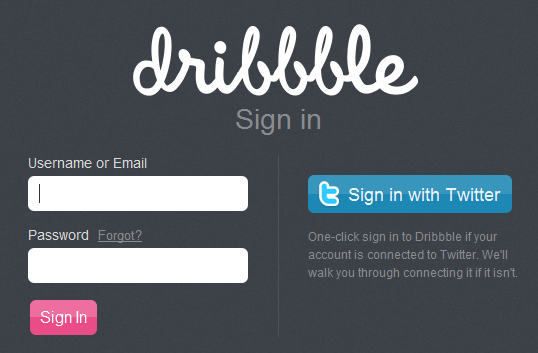About registration on sites
We often perform on many sites an action that is constantly evolving and improving (and sometimes vice versa). This is a registration. I would like to talk about different methods and features of registrations on sites. This is not a cumbersome study, but simply small and (I hope) useful extracts from my experience as an interface designer.

An example of a successful registration on the site Tumblr .
I will begin by defining the very concept of “registration”, everything is not as simple with it as it may seem. As a result of the field research of our company, it turned out that different people (customers, visitors and ourselves) often perceive this word differently. In order to avoid misunderstanding, I will describe how I myself see the registration.
Registration is a way to communicate information about yourself to the site and in exchange get access to additional features (for example, adding something to your favorites) or resources (for example, files) on the site that are not available to guests.
Registration is inseparable without authorization. In fact, registration is a way to get an opportunity to enter the site.
Often registration is required to access the site. Often this happens on social networks, where the possibilities of guests are limited by definition.
But is it necessary to register on the site for most projects?
')

An example of registration on Facebook , which requests a lot of data.
By “ordinary” I mean registration on the site, in exchange for which I receive a login and password, which I myself entered. In this case, the login here can be anything.

The standard way to register on the site StartupPoint .
I want to highlight a few of theses:
By this definition, I mean registration using an account in social networks, using an OpenID identifier (almost dead technology for the masses) and, separately, registration with an account of large systems like Google, Yandex and others. Yes, sometimes it is also OpenID inside, but for an outsider the very definition of “OpenID” is a filkin letter.

Registration with the help of third-party services on the site Kinobaza .

An example of a dialogue asking for access to data on Twitter .
So we call registration, which does not look like a separate process and occurs as important actions are performed. Usually, for soft registration, you only need an email address to send a password to it and an invitation to enter the site. If a person does not need this, then he will simply delete this letter or ignore it, but for those who doubt it, this will create one more way to enter the site, which rather strongly affects the registration efficiency.

An example of soft registration on the site SoundCloud .
We often use soft registration as the main way to integrate a person, precisely because he does not confuse visitors and allows the user to quickly enter the site.
As an example, you can bring a soft registration in the process of placing an order on the website of the online store. The store inevitably asks the person his email address in order to be able to contact him and confirm the order. So why not use it for soft registration? If the visitor has not previously entered this mail on the site, then he will immediately receive a password to access his personal account with a lot of additional useful features, and if entered, just a reminder that an account with such an email already exists and you can attach an order to him

Registration during ordering on the website of the online store Rosette .
The main thing - do not push. Soft registration is called because it helps a person to make a choice and simplifies his life, and not imposed.
This method allows you to engage a person in the registration process so that he will like it, even if he notices him. And gradual involvement is a strong thing, much more effective when compared with the usual registration form.
Give an answer to a couple of questions and you will understand:
If you answered “Yes” to at least two questions, then you still need to register it :)
Why not everything? In almost all projects, you can implement the usual method of registration, along with the ability to get an account through social networks and large projects. A soft registration can be applied at the time of the first important action on the site or through an enticing function (more about that another time).

Two ways to register on the site Dribbble .
There are a few exceptions:
PS: A couple of years ago I wrote two articles about how, in my opinion, registration should look like. Then I approached the issue solely from the implementation side, not covering the issues of which registration methods exist at all and where they should be applied.
After the last article, a lot of water flowed away and more experience was gained, because in this article I can contradict myself-past :)
PPS from the author : I hope you enjoyed the article. I would be glad if you point out mistakes so that I can fix them quickly. Write me in PM, please :)

An example of a successful registration on the site Tumblr .
I will begin by defining the very concept of “registration”, everything is not as simple with it as it may seem. As a result of the field research of our company, it turned out that different people (customers, visitors and ourselves) often perceive this word differently. In order to avoid misunderstanding, I will describe how I myself see the registration.
What is registration?
Registration is a way to communicate information about yourself to the site and in exchange get access to additional features (for example, adding something to your favorites) or resources (for example, files) on the site that are not available to guests.
Registration is inseparable without authorization. In fact, registration is a way to get an opportunity to enter the site.
Often registration is required to access the site. Often this happens on social networks, where the possibilities of guests are limited by definition.
But is it necessary to register on the site for most projects?
')
Why do I need to register?
- A site owner needs registration to create a sustainable community with social connections between users. In exchange, the administration gets the opportunity to interact with its visitors directly, which is quite difficult to do with anonymous users :)
- Marketers , registration, of course, is needed to obtain data about visitors and the opportunity to announce various new features of the project, as well as advertise sponsors. It also allows you to build quite slim statistics: who are our users, what do they want? In the long run, this can be very useful, because knowing the users and their needs, we create a website just for a specific audience, and not for spherical horses in a vacuum.
- Developer registration is needed, because it allows you to bind to the user account a lot of opportunities on the site, which are quite difficult to implement for guests. Also registration allows you to distribute access rights to various resources and opportunities on the site, which also makes life easier for programmers.
- Most site visitors do not really need registration. In most cases, he does not need additional opportunities; he is content with little. Often, people do not understand its essence at all: what, in general, is this mysterious registration? Often this word is associated with bureaucracy and passport desks, which scares off potential users. However, it is necessary to mention that social networks gradually educate users and allow them to gain the first registration experience. After that, most people are much more loyal to the registration process and understand what is behind it.

An example of registration on Facebook , which requests a lot of data.
Regular Registration
By “ordinary” I mean registration on the site, in exchange for which I receive a login and password, which I myself entered. In this case, the login here can be anything.

The standard way to register on the site StartupPoint .
I want to highlight a few of theses:
- I believe that in a regular registration there should be a minimum of fields to fill out . Ideally - login, password and duplicate password to avoid typos.
- Login can be anything . However, as a result of a long work on this issue, I came to the conclusion that it is best to use e-mail for an average and highly advanced audience, as well as a telephone number for mass services and projects. And it is better to give the user a choice. Using a name, nickname or unique ID as a login is not a good idea, which causes more problems than it solves.
- It is not necessary to create artificial frames when entering a password . If a person wants to enter "12345", then he should not be prohibited, however, it is better to notify him that it is very unsafe, entails great opportunities for the account to be "hacked" by attackers and should not be done. An intelligent person will understand this, if he is clearly explained, and this will not stop the unwise.
- It is better to leave the field to re-enter the password . Blindly people are often sealed, and if you do not hide the password field, the user will not register on the site from public places, which is also a big limitation.
- I don't think Captcha is a good way to sift bots . To be precise, I do not mind its use, however, only after the user has entered his password incorrectly several times. This is a fairly obvious sign that the password is being searched. The ideal solution for such cases is to consider a captcha convenient for a person and a link to password recovery with explanations in case it is a real person who has forgotten his password.
Registration with third-party sites
By this definition, I mean registration using an account in social networks, using an OpenID identifier (almost dead technology for the masses) and, separately, registration with an account of large systems like Google, Yandex and others. Yes, sometimes it is also OpenID inside, but for an outsider the very definition of “OpenID” is a filkin letter.

Registration with the help of third-party services on the site Kinobaza .
- The most painless way to register now is through an account on social networks and big projects like Google. The site owner allows him to quickly integrate into a social network, and most people do not have to register on another site: create a password, shine their email.
- OpenID is almost dead as a brand, but thriving as technology. If you plan to give such an opportunity to users, do not mention this word: it is misleading people and misunderstanding. It's easier to write “sign in using your account on the site” and the list: Google, Yandex, Odnoklassniki
- In the registration through third-party sites, there is one pitfall: after choosing a service, people are given a dialogue asking them to allow access to their personal data. And this is precisely the point at which most registrations through social networks stop. If people do not trust the site, then they most likely will not give permission. However, trust is a topic for a completely different article :)

An example of a dialogue asking for access to data on Twitter .
Soft registration
So we call registration, which does not look like a separate process and occurs as important actions are performed. Usually, for soft registration, you only need an email address to send a password to it and an invitation to enter the site. If a person does not need this, then he will simply delete this letter or ignore it, but for those who doubt it, this will create one more way to enter the site, which rather strongly affects the registration efficiency.

An example of soft registration on the site SoundCloud .
We often use soft registration as the main way to integrate a person, precisely because he does not confuse visitors and allows the user to quickly enter the site.
As an example, you can bring a soft registration in the process of placing an order on the website of the online store. The store inevitably asks the person his email address in order to be able to contact him and confirm the order. So why not use it for soft registration? If the visitor has not previously entered this mail on the site, then he will immediately receive a password to access his personal account with a lot of additional useful features, and if entered, just a reminder that an account with such an email already exists and you can attach an order to him

Registration during ordering on the website of the online store Rosette .
The main thing - do not push. Soft registration is called because it helps a person to make a choice and simplifies his life, and not imposed.
This method allows you to engage a person in the registration process so that he will like it, even if he notices him. And gradual involvement is a strong thing, much more effective when compared with the usual registration form.
Do I need to register at all
Give an answer to a couple of questions and you will understand:
- Does your project have some useful additional features for registered users, for which visitors will be registered?
- Do you plan to build a community around your site?
- Do you need additional visitor data?
- Do you have a distribution of roles on the project?
- Do you need to interact with the audience of the site?
If you answered “Yes” to at least two questions, then you still need to register it :)
What method of registration to use
Why not everything? In almost all projects, you can implement the usual method of registration, along with the ability to get an account through social networks and large projects. A soft registration can be applied at the time of the first important action on the site or through an enticing function (more about that another time).

Two ways to register on the site Dribbble .
There are a few exceptions:
- Services that are closely related to money should not be integrated with other sites and services - this can jeopardize account security. However, in such cases, soft registration involvement can be used along with the standard method.
- Soft registration is not always a good way to engage if there is no major action on the project. Such an action in the online store is the selection and ordering of goods. Take a good look at your project and highlight such an action. Can I start it without an account? If yes, then a soft registration for you.
- Regular registration almost does not work, compared to other methods, if the project is really massive and is aimed at the widest audience with low computer literacy.
PS: A couple of years ago I wrote two articles about how, in my opinion, registration should look like. Then I approached the issue solely from the implementation side, not covering the issues of which registration methods exist at all and where they should be applied.
After the last article, a lot of water flowed away and more experience was gained, because in this article I can contradict myself-past :)
PPS from the author : I hope you enjoyed the article. I would be glad if you point out mistakes so that I can fix them quickly. Write me in PM, please :)
Source: https://habr.com/ru/post/134595/
All Articles